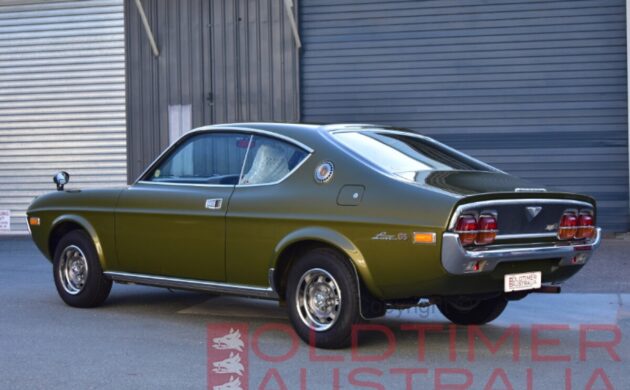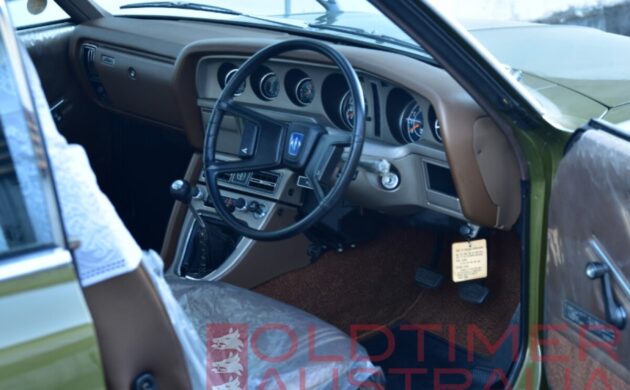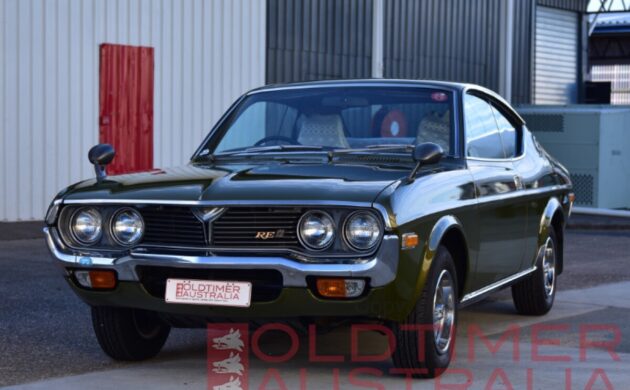Occasionally, a classic car will emerge that is incredibly well-preserved and could serve as a museum piece. Such is the case with this 1973 Mazda Luce GS. Known in export markets as the RX-4, this vehicle started its life in Japan, where its original owner used it sparingly until ill health forced him to park it in 1985. It found its way to Hamilton, Queensland, Australia, in 2013, thanks to a genuine Mazda enthusiast. After reviving the Mazda and returning it to a roadworthy state, they feel it needs a new home. Therefore, they have listed it here at Oldtimer Australia. You need to draw a deep breath if you wish to park this Luce in your driveway because the price is an eye-watering A$149,950 (US$101,000)!
Mazda launched the LA2 version of its Luce model in November 1972. The company produced the model with standard internal combustion engines and the legendary Wankel rotary powerplant. The company rebadged the latter models as the RX-4 for export markets while retaining the “Luce” designation domestically. Our feature car spent most of its life on home soil under the care of a meticulous first owner. They drove the car sparingly until 1985, when they parked it due to failing health. An Australian enthusiast located this classic and exported it in 2013. When they examined the car, they were astounded by its condition. It wears its original Jewel Green Metallic paint that presents superbly. There is no evidence of flaws or deterioration, suggesting the storage environment was ideal. The panels are as straight as they were the day the vehicle rolled off the line, and there is no evidence of rust. The trim and glass are flawless, as are the styled steel wheels with their trim rings and center caps. It is risky to describe an unrestored vehicle of this age as perfect, but it is probably the best 100% original example you will ever see.
When German engineer Felix Wankel unveiled his rotary engine, it promised a revolution in automobile design. Its compact dimensions, smooth nature, and ability to produce extraordinary power levels from modest capacities seemed to make it a game-changer. It showed such promise that General Motors and AMC investigated adopting it for their domestic products, while NSU fitted their version to the Ro80 model. Unfortunately, reliability issues plagued the rotary, although Mazda spent years and considerable sums of money to eradicate the problems. This Luce features the 12A version with a nominal capacity of 1,146cc. For such a tiny motor, a power figure of 118hp looks impressive. However, the torque figure of 115 ft/lbs is modest, meaning that these little engines don’t burn the bitumen when pointed at a ¼-mile. Even with a four-speed manual transmission, as we find here, that journey takes 18.1 seconds. However, the free-revving nature of these sweet little motors means this Mazda should find its way to 118mph. After years of hibernation, the seller was impressed by what they found after taking delivery of this classic. Reviving it proved surprisingly straightforward. They cleaned the fuel and hydraulic systems, rebuilt the rear brakes, performed a complete service, and added new tires. The car runs and drives well, and they include the original tires for display purposes. It has a genuine 6,397 kilometers (3,974 miles) showing on its odometer, and the seller holds a complete service history verifying the claim.
Considering this Mazda’s history, its factory-fresh interior is no surprise. However, after nearly five decades, few would expect to find the factory’s protective plastic covers intact. As a result, there are no faults or issues to note. The original owner wanted some comfort when perched on that plastic behind the wheel, so the seats wear lace doilies. This was a common touch in Japan, and I would leave them in place if I found this gem in my driveway to acknowledge the car’s history. The Luce’s sporting credentials are underlined by the comprehensive gauge cluster, while the AM/FM stereo radio and factory 8-track player add welcome luxury touches.
Mazda created its “RX” series of road cars as performance models, although the RX-4 added luxury touches to broaden its appeal. The nature of the Wankel rotary engine virtually guaranteed that owners would drive them hard and fast, and many have long since found their way to automotive graveyards. It is doubtful you will find another 1973 Luce GS as beautifully preserved unless you visit Mazda’s factory museum. That begs the question of whether the seller will succeed in realizing their asking price. It is undeniably a lot of money, and I doubt they will be inundated with potential buyers beating down their doors. Even if they do, I suspect it will rarely (if ever) see active duty. My instincts suggest the future of this Mazda is as a display piece, which is not what its creators intended. Do you agree?






These are such beautiful cars in styling and this one is a gem. Never a fan of the Rotary engine, these cars would do, IMHO, with a “date coded” high performance conventional gas engine of the time. Certainly not this one considering overall care and condition. This was a great time in styling for imports.
I’m with you on the ’70s era Japanese styling. Had a ’74 Celica and would’ve loved a 240z; both still beautiful to look at IMO, and the RX4 looks really put-together as well.
Had two rotarys, RX-2 and RX-3. The RX-2 ran the fastest, with its single distributor. Both motors quick running after 3 years. I think from over heating. They were fun to drive. Good luck on the asking price, unless it goes into a collection somewhere that has unlimited funds.
73 with 6400 Kilometers, with that mileage alone I would love to own it even though I am a FE Ford fan and was drag racing mine at the Beaver Springs Dragway this past weekend. It’s a keeper that needs to be kept in the temperature-controlled garage. I would like to find a 68 GT500KR in that condition and that price, well, that’s another story.
The Wankel is one of those engineering concepts that’s far better on paper than it is in actual use. Wankel engines are expensive to build, have weak torque output, consume copious amounts of oil, are difficult to tune for emissions standards, and deliver abysmal fuel economy. The engines are small, light, and are a hoot to operate, with redlines approaching 10,000 RPM, but that’s just not enough to overcome the fundamental weaknesses.
Yes, my SIL had an RX8 that was beautiful to behold, ran like the proverbial scalded dog, and, as you noted, got bad MPG and needed major engine work every X number of miles. He still misses it though, and I don’t blame him.
Beautiful car. I used to work for a Mazda dealership and rebuilt several engines. They are really pretty simple and not expensive. The short comings have been mentioned but I’d love to have another one but not for that price.
When I was a kid. Rotary’s were all the rage. They were the NEXT BIG THING. GM was going to put one into the Corvette. All the car mags told us that this was the future. AMC designed an entire car around it. Then, the fog lifted, and the drawbacks soon overcame the plusses. Does this sound familiar today?
Very similar styling to the Datsun B210. They became rust buckets pretty quickly. And I mean, fred flintstone braking was an option.
It’s pretty hard to argue with the condition of this car, and it’s doubtful there are many more on earth this nice, but the price is still eye watering. I too like the styling, including the interior design.
In some ways, it’s sort of uncanny how the body lines and style have a similar look to the Ford Maverick that was on today’s email alert as well. Both are pleasing to look at.
Much much to high for me to consider, but hopefully it will go somewhere it will be preserved.
One day back around 1974 I was hanging out at a carwash where a friend worked. Another friend, who worked for a vinyl top installer, stopped by with a green RX-4 that he was driving from a Mazda dealer to the vinyl top shop to get a vinyl top installed. Most dealers farmed out that work back in the day.
The RX-4 was backed up to an evergreen bush and my friend was revving the engine since it was our first experience with a rotary. That thing could sing! The bush eventually caught on fire, the exhaust was so hot! Man, I remember that day like it was yesterday…
These are all the rage amongst tuners down under. This will fetch this price down under. It would be interesting to see if it gets a tuner treatment, or is left pristine.
As everyone has said, such beautiful styling.
I had a new 1974 RX-4 sedan with auto transmission. It looked great in it’s BRG colour. I think it topped out at around 110mph and as previously noted, I recall an average economy (!) of 11mpg if driven a little hard :-).
Awesome looking car. Although I was way too young at the time to drive, I remember cars like this.
I had an RX-4 wagon and later an RX-7. The wagon was a hoot…4 speed with the 13B. One odd thing I recall is that it had explosive seatbelt tensioners. Always wondered if they would actually work in a collision.
I’ve mentioned it here before that my parents had a ’74 RX-4 “Rotary Wagon” – it said that on the side I remember – right when I got my driver’s license.
What a funky ride, I haven’t seen another one in person since then.
never more a true ’60s fishy TV star:
https://www.youtube.com/watch?v=azEOeTX1LqM
Rotary engines used oil by design, they have an injection system in place that added oil to the combustion chamber. Yes they aren’t fuel efficient by design the engine fires 3 times for each revolution. That’s the power band. Had numerous rotary powered RX-7 vehicles and don’t overheat them and keep the oil changed in the engine and have fun reving them all day long.